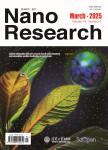Biotinylated polyurethane-urea nanoparticles for targeted theranostics in human hepatocellular carcinoma
Biotinylated polyurethane-urea nanoparticles for targeted theranostics in human hepatocellular carcinoma作者机构:Department of Pharmacy and Pharmaceutical Technology Faculty of Pharmacy University of Barcelona Av Joan XXIII s/n 08028 Barcelona Spain Institute of Advanced Chemistry of Catalonia (IQAC) CS/C Jordi Girona 18-26 08034 Barcelona Spain Networking Research Center on Bioengineering Biomaterials and Nanomedicine CIBER-BBN Spain
出 版 物:《Nano Research》 (纳米研究(英文版))
年 卷 期:2015年第8卷第5期
页 面:1729-1745页
核心收录:
学科分类:071011[理学-生物物理学] 0710[理学-生物学] 071010[理学-生物化学与分子生物学] 07[理学]
基 金:sponsorship of the Spanish Ministry of Education and Science, DGI “Generalitat de Catalunya” DURSI CIBER-BBN.CIBERBBN is an initiative funded by the VI National R&D&i Plan 2008-2011,Iniciativa Ingenio 2010,Consolider Program,CIBER Actions and financed by the Instituto de Salud Carlos III with assistance from the European Regional Development Fundation
主 题:cancer therapy DNA nanoparticles polyurethane theranostics
摘 要:Over the past years, significant efforts have been devoted to explore novel drug delivery and detection strategies for simultaneous therapy and diagnostics. The development of biotinylated polyurethane-urea nanoparticles as theranostic nanocarriers for targeted drug and plasmid delivery, for fluorescence detection of human hepatocellular carcinoma cells, is described herein. These targeted nanoparticles are specifically designed to incorporate biotin into the polymeric matrix, since many tumor types overexpress receptors for biotin as a mechanism to boost uncontrolled cell growth. The obtained nanoparticles were spherical, exhibited an average diameter ranging 110-145 nm, and showed no cytotoxicity in healthy endothelial cells. Biotinylated nanoparticles are selectively incorporated into the perinuclear and nuclear area of the human hepatocellular carcinoma cell line, HepG2, in division, but not into growing, healthy, human endothelial cells. Indeed, the simultaneous incorporation of the anticancer drugs, phenoxodiol or sunitinib, together with plasmid DNA encoding green fluorescent protein, into these nanoparticles allows a targeted pharmacological antitumor effect and furthermore, selective transfection of a reporter gene, to detect these cancer cells. The combined targeted therapy and detection strategy described here could be exploited for liver cancer therapy and diagnostics, with a moderate safety profile, and may also be a potential tool for other types of cancer.




